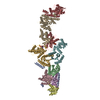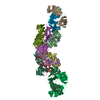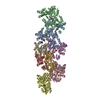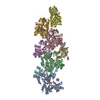+ Open data
Open data
- Basic information
Basic information
| Entry | Database: SASBDB / ID: SASDFL5 |
|---|---|
 Sample Sample | Plasmodium falciparum Hsp70/Hsp90 organizing protein, Hop
|
| Function / homology |  Function and homology information Function and homology informationHSP90 chaperone cycle for steroid hormone receptors (SHR) in the presence of ligand /  Hsp90 protein binding / Hsp90 protein binding /  cytosol cytosolSimilarity search - Function |
| Biological species |   Plasmodium falciparum (isolate 3D7) (eukaryote) Plasmodium falciparum (isolate 3D7) (eukaryote) |
 Citation Citation |  Journal: Biochim Biophys Acta Proteins Proteom / Year: 2020 Journal: Biochim Biophys Acta Proteins Proteom / Year: 2020Title: Structural studies of the Hsp70/Hsp90 organizing protein of Plasmodium falciparum and its modulation of Hsp70 and Hsp90 ATPase activities. Authors: Noeli S M Silva / Dayane E Bertolino-Reis / Paulo R Dores-Silva / Fátima B Anneta / Thiago V Seraphim / Leandro R S Barbosa / Júlio C Borges /  Abstract: HOP is a cochaperone belonging to the foldosome, a system formed by the cytoplasmic Hsp70 and Hsp90 chaperones. HOP acts as an adapter protein capable of transferring client proteins from the first ...HOP is a cochaperone belonging to the foldosome, a system formed by the cytoplasmic Hsp70 and Hsp90 chaperones. HOP acts as an adapter protein capable of transferring client proteins from the first to the second molecular chaperone. HOP is a modular protein that regulates the ATPase activity of Hsp70 and Hsp90 to perform its function. To obtain more detailed information on the structure and function of this protein, we produced the recombinant HOP of Plasmodium falciparum (PfHOP). The protein was obtained in a folded form, with a high content of α-helix secondary structure. Unfolding experiments showed that PfHOP unfolds through two transitions, suggesting the presence of at least two domains with different stabilities. In addition, PfHOP primarily behaved as an elongated dimer in equilibrium with the monomer. Small-angle X-ray scattering data corroborated this interpretation and led to the reconstruction of a PfHOP ab initio model as a dimer. Finally, the PfHOP protein was able to inhibit and to stimulate the ATPase activity of the recombinant Hsp90 and Hsp70-1, respectively, of P. falciparum. Our results deepened the knowledge of the structure and function of PfHOP and further clarified its participation in the P. falciparum foldosome. |
 Contact author Contact author |
|
- Structure visualization
Structure visualization
| Structure viewer | Molecule:  Molmil Molmil Jmol/JSmol Jmol/JSmol |
|---|
- Downloads & links
Downloads & links
-Data source
| SASBDB page |  SASDFL5 SASDFL5 |
|---|
-Related structure data
| Similar structure data |
|---|
- External links
External links
| Related items in Molecule of the Month |
|---|
-Models
| Model #2962 |  Type: dummy / Software: (DAMFILT 5.) / Radius of dummy atoms: 3.00 A / Symmetry  : P2 / Chi-square value: -1.000 : P2 / Chi-square value: -1.000 Search similar-shape structures of this assembly by Omokage search (details) Search similar-shape structures of this assembly by Omokage search (details) |
|---|---|
| Model #2973 |  Type: dummy / Radius of dummy atoms: 3.00 A / Symmetry  : P2 / Chi-square value: -1.000 : P2 / Chi-square value: -1.000 Search similar-shape structures of this assembly by Omokage search (details) Search similar-shape structures of this assembly by Omokage search (details) |
- Sample
Sample
 Sample Sample | Name: Plasmodium falciparum Hsp70/Hsp90 organizing protein, Hop Specimen concentration: 1.00-2.80 |
|---|---|
| Buffer | Name: 25 mM Tris-HCl, 100 mM NaCl, 1 mM EDTA, 1 mM β-mercaptoethanol pH: 8 |
| Entity #1620 | Name: PfHop / Type: protein / Description: STI1-like protein / Formula weight: 68.219 / Num. of mol.: 2 / Source: Plasmodium falciparum (isolate 3D7) / References: UniProt: Q8ILC1 Sequence: MGSSHHHHHH SSGLVPRGSH MVNKEEAQRL KELGNKCFQE GKYEEAVKYF SDAITNDPLD HVLYSNLSGA FASLGRFYEA LESANKCISI KKDWPKGYIR KGCAEHGLRQ LSNAEKTYLE GLKIDPNNKS LQDALSKVRN ENMLENAQLI AHLNNIIEND PQLKSYKEEN ...Sequence: MGSSHHHHHH SSGLVPRGSH MVNKEEAQRL KELGNKCFQE GKYEEAVKYF SDAITNDPLD HVLYSNLSGA FASLGRFYEA LESANKCISI KKDWPKGYIR KGCAEHGLRQ LSNAEKTYLE GLKIDPNNKS LQDALSKVRN ENMLENAQLI AHLNNIIEND PQLKSYKEEN SNYPHELLNT IKSINSNPMN IRIILSTCHP KISEGVEKFF GFKFTGEGND AEERQRQQRE EEERRKKKEE EERKKKEEEE MKKQNRTPEQ IQGDEHKLKG NEFYKQKKFD EALKEYEEAI QINPNDIMYH YNKAAVHIEM KNYDKAVETC LYAIENRYNF KAEFIQVAKL YNRLAISYIN MKKYDLAIEA YRKSLVEDNN RATRNALKEL ERRKEKEEKE AYIDPDKAEE HKNKGNEYFK NNDFPNAKKE YDEAIRRNPN DAKLYSNRAA ALTKLIEYPS ALEDVMKAIE LDPTFVKAYS RKGNLHFFMK DYYKALQAYN KGLELDPNNK ECLEGYQRCA FKIDEMSKSE KVDEEQFKKS MADPEIQQII SDPQFQIILQ KLNENPNSIS EYIKDPKIFN GLQKLIAAGI LKVR |
-Experimental information
| Beam | Instrument name: Brazilian Synchrotron Light Laboratory SAXS1 Beamline City: Campinas / 国: Brazil  / Type of source: X-ray synchrotron / Type of source: X-ray synchrotron Synchrotron / Wavelength: 0.1488 Å / Dist. spec. to detc.: 0.9 mm Synchrotron / Wavelength: 0.1488 Å / Dist. spec. to detc.: 0.9 mm | ||||||||||||||||||||||||||||||||||||
|---|---|---|---|---|---|---|---|---|---|---|---|---|---|---|---|---|---|---|---|---|---|---|---|---|---|---|---|---|---|---|---|---|---|---|---|---|---|
| Detector | Name: Pilatus 300K / Type: 20Hz | ||||||||||||||||||||||||||||||||||||
| Scan | Measurement date: Aug 3, 2016 / Cell temperature: 20 °C / Exposure time: 100 sec. / Number of frames: 1 / Unit: 1/A /
| ||||||||||||||||||||||||||||||||||||
| Distance distribution function P(R) |
| ||||||||||||||||||||||||||||||||||||
| Result | Comments: Top: The model represents the averaged spatial disposition (volume and bead-occupancy corrected; damfilt model) obtained from several spatially aligned individual dummy atom model (DAM) ...Comments: Top: The model represents the averaged spatial disposition (volume and bead-occupancy corrected; damfilt model) obtained from several spatially aligned individual dummy atom model (DAM) reconstructions calculated using DAMMIF. Bottom: A single DAMMIF representative model with the lowest NSD from the aligned DAM cohort. The corresponding fit to the SAXS data is displayed.
|
 Movie
Movie Controller
Controller














